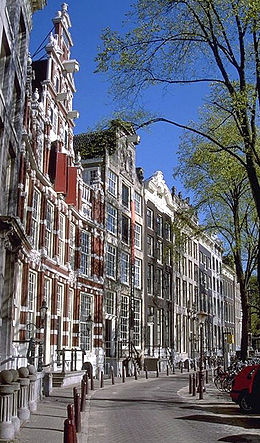- Michael Reyniersz Pauw
-
New Netherland series Exploration Fortifications: • Fort Nassau (North)
• Fort Orange
• Fort Nassau (South)
• Fort Goede Hoop
• De Wal
• Fort Wilhelmus
• Fort Beversreede
• Fort Nya Korsholm
• De Rondout
Settlements: • Rensselaerswyck
• Beverwijck
• Wiltwyck
• Bergen
• Pavonia
• Vriessendael
• Achter Col
• Heemstede
• Rustdorp
• Midwout
• Boswyck
• Swaanendael
The Patroon System Directors of New Netherland: Cornelius Jacobsen May (1620-25)
Willem Verhulst (1625-26)
Peter Minuit (1626-32)
Sebastiaen Jansen Krol (1632-33)
Wouter van Twiller (1633-38)
Willem Kieft (1638-47)
Peter Stuyvesant (1647-64)
People of New Netherland Flushing Remonstrance  The greyish mansion in the middle, belonging to Pauw, was painted by Jan van der Heyden
The greyish mansion in the middle, belonging to Pauw, was painted by Jan van der Heyden
Knight Michiel Reiniersz Pauw (29 March 1590, Amsterdam[1] - 20 March 1640, Amsterdam) was a burgermeester of Amsterdam and a director of the Dutch West India Company (WIC)[2]
He was born in Amsterdam in a rich merchant family - his father, Reinier Pauw (1564–1636) wasn't only a merchant, but also a Mayor of Amsterdam - and studied law in Leiden. His brother Adriaan Pauw [3] (1581 - February 21, 1653 [2]) was Grand Pensionary of Holland from 1631 to 1636 and from 1651 to 1653, and signatory of the Peace of Münster (1648) for which he was instrumental as ambassador for Holland.
The WIC was founded in 1621 to exploit trade in the Western Hemisphere,[4] and by 1625 had established a colony at Fort Amsterdam (Lower Manhattan) and Fort Orange. In the hope of encouraging settlement the company, in 1629, started to offer vast land grants and the feudal title of patroon.[5] under the auspices of the Charter of Freedoms and Exemptions. In 1630, Pauw purchased two tracts from the Lenape at Hopoghan Hackingh (Hoboken) and at Ashasimus (Harsimus), though the patroonship likely included the entire peninsula between the Hudson River and Hackensack River now known as Hudson County, New Jersey, and possibly his holdings on Staten Eylandt (Staten Island). It was given the Latinized form of his surname (which means "peacock"), Pavonia. It is said it was sold to him by the Manhattans after they had retreated there after the sale of their home island to Peter Minuit some years before. Initially, a small hut and ferry landing were built at Arresick, called Powles Hoek (Paulus Hook), but Pauw failed to fulfill the other conditions set forth by the company (which included populating the area with at least fifty adults),[5] and was later required to sell his interests back to it.[6] In 1634 he collaborated with Kiliaen van Rensselaer and Wouter van Twiller in sending cattle (horses and cows) in the next six years.[7]
The name Pavonia remains as an avenue and library branch in contemporary Jersey City. There is also a Pavonia Court in Bayonne and Pavonia Avenue in Kearny. Erie Railroad's Hudson waterfront terminus was called Pavonia Terminal located nearby PATH rapid transit system's station once called Pavonia. Saint Peter's College, located on land that was part of the patroonship, has as its mascot a peacock.
Pavonia was not the only American territory that would bear his name. First described by Amerigo Vespucci, who traveled with a Portuguese expedition of Gonçalo Coelho to Brazil in the year 1503, the Fernando de Noronha Archipelago was invaded by the English, and from 1556 until 1612, was held by the French. In 1628, it was occupied by the Dutch, who were displaced two years later by a Spanish-Portuguese military expedition led by Rui Calaza Borges. The Dutch occupied the island once again in 1635, making it a hospital for their troops who occupied Northeastern Brazil (the Brazilian coast between Rio São Francisco and Maranhão). The island became known as Pavonia, in honor of Pauw. It would remain under Dutch control for nearly twenty years, when it was reconquered by Portugal.
Pauw was apparently very successful, and was able to commission one of the most popular architects of the period to build a grachtenpand, or canal house, in Amsterdam. Clad in white sandstone imported from Germany it was the first in the city have a neck gable. [8]
References
- ^ Baptized 8 April 1590 in the Nieuwe Kerk, Mijchgiel, son of Reijier Pau and Cornelisgen Mijchgiels [1]
- ^ http://www.publicbookshelf.com/public_html/Our_Country_Vol_1/newnether_eg.html
- ^ http://www.herenvanholland.nl/eigenaar.cfm?eigenaarnummer=472
- ^ The Avalon Project : Charter of the Dutch West India Company : 1621
- ^ a b Johan van Hartskamp, De Westindische Compangnie en haar Belangen in Niuew-Nederland, een overzicht (1621-1664)http://stuyvesant.library.uu.nl
- ^ http://www.kellscraft.com/DutchEnglishOnHudson/DutchEnglishOnHudsonCh03.html
- ^ NA 373, f. 129-130, Not. W. Cluijt, 13 April 1634
- ^ http://www.theaterinstituut.nl/en/theatermuseum/theatermuseum/de_panden
Categories:- 1590 births
- 1640 deaths
- Dutch businesspeople
- People from Amsterdam
- People of New Netherland
- Dutch West India Company
Wikimedia Foundation. 2010.


